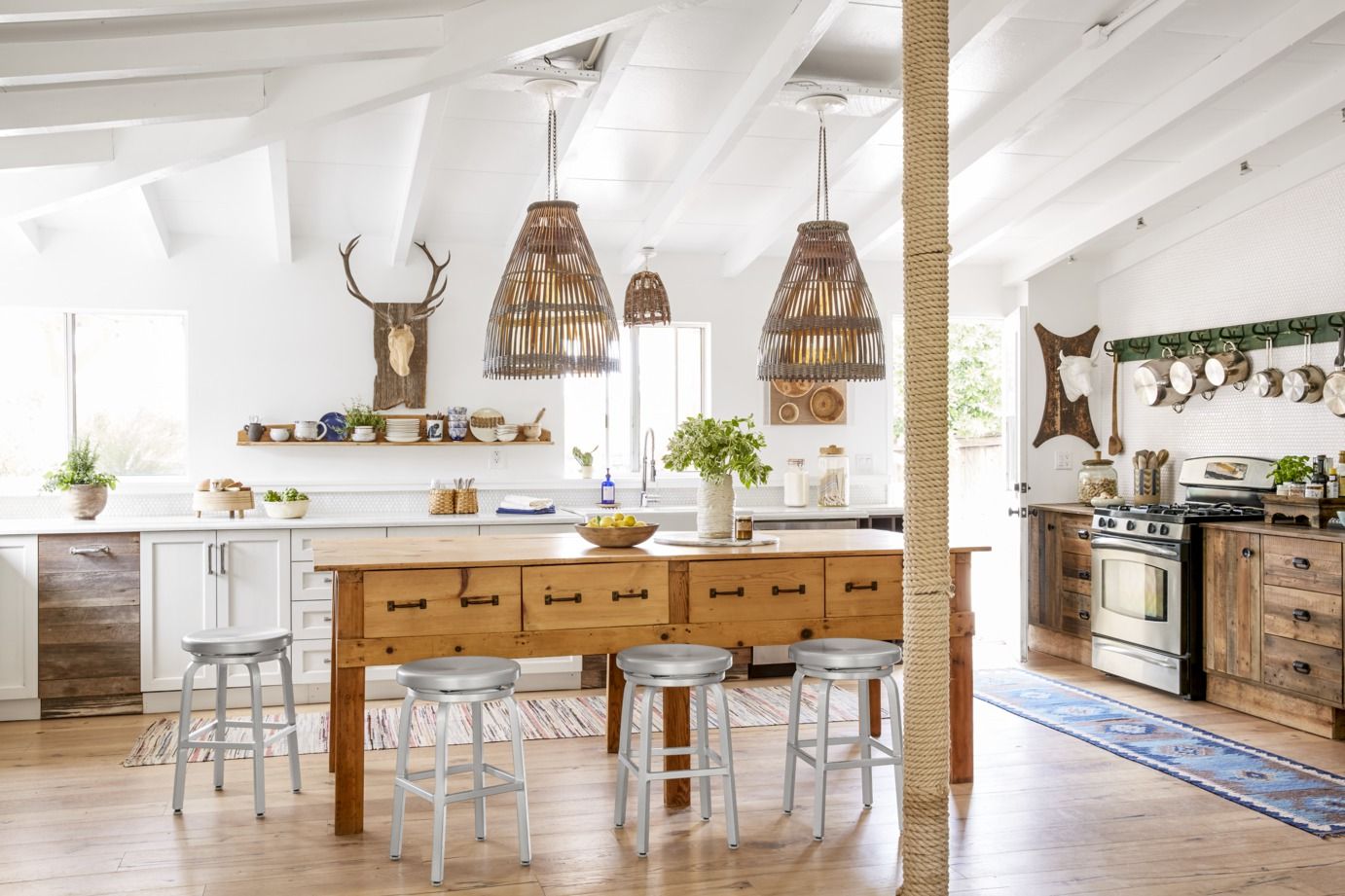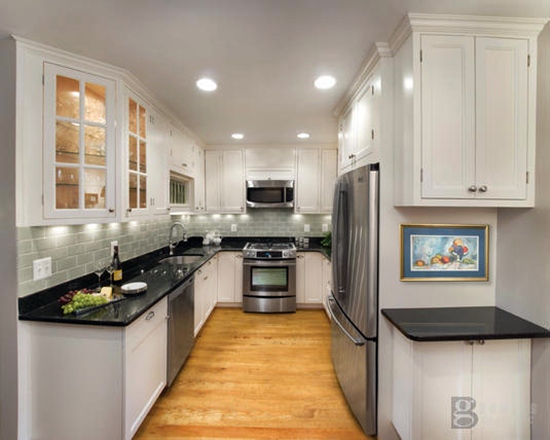Kitchen lighting plays an important role in creating the right atmosphere and functionality in your kitchen. There are several types of kitchen lighting to choose from, each with its own unique features and benefits. Task Lighting: This type of lighting is specifically designed to provide focused, bright light in work areas such as the countertop, stove, and sink. Task lighting is essential for performing tasks such as cooking, chopping, and cleaning in the kitchen. Ambient Lighting: Ambient lighting provides overall illumination in the kitchen and creates a warm and inviting atmosphere. This can be achieved through ceiling lights, chandeliers, or pendant lights. Accent Lighting: Accent lighting is used to highlight specific areas or features in the kitchen, such as a beautiful backsplash or a piece of artwork. This type of lighting adds depth and dimension to the space.1. Types of Kitchen Lighting
Choosing the right kitchen lighting can be overwhelming, but it doesn't have to be. Here are some factors to consider when selecting the perfect lighting for your kitchen. Functionality: Think about how you use your kitchen and what tasks you perform in the space. This will help determine the type of lighting you need, whether it's task lighting for cooking or ambient lighting for entertaining. Style: Your kitchen lighting should complement the overall style of your kitchen. For a modern kitchen, choose sleek and minimalistic fixtures, while for a more traditional kitchen, opt for classic and elegant lighting. Budget: Lighting can range from budget-friendly options to more expensive fixtures. Determine your budget beforehand to narrow down your choices and ensure you don't overspend.2. How to Choose the Right Kitchen Lighting
Designing the lighting for your kitchen is an important part of creating a functional and beautiful space. Here are some ideas to inspire your kitchen lighting design. Layered Lighting: A combination of task, ambient, and accent lighting creates a layered effect, adding depth and dimension to your kitchen. This also allows for flexibility in lighting depending on the time of day and tasks being performed. Under Cabinet Lighting: Installing lights under your cabinets not only provides task lighting for your countertop but also adds a soft, ambient glow to your kitchen. It also creates a sense of depth and can make your kitchen appear larger. Statement Lighting: Make a statement in your kitchen by choosing a unique and eye-catching light fixture. This could be a chandelier, pendant lights, or a bold ceiling light.3. Kitchen Lighting Design Ideas
The right lighting fixtures can make all the difference in your kitchen. Here are some of the best kitchen lighting fixtures to consider. Pendant Lights: These are a popular choice for kitchens as they come in a variety of styles and can be hung at different heights to create a dramatic effect. They also provide focused light for specific areas. Recessed Lights: Also known as can lights, recessed lights are installed into the ceiling and provide overall illumination in the kitchen. They are a great option for small spaces as they don't take up any room. Sconces: Sconces are mounted onto the wall and provide a soft, diffused light. They're perfect for adding a touch of elegance to your kitchen and work well as accent lighting.4. Best Kitchen Lighting Fixtures
The layout and placement of your kitchen lighting are crucial in creating a functional and well-lit space. Here are some tips for getting the lighting layout right. Task Lighting: Install task lighting above areas where you perform specific tasks, such as the sink, stove, and countertop. This will ensure that you have enough light to work by. Ambient Lighting: For ambient lighting, consider the size and shape of your kitchen when deciding on the placement. A larger kitchen may require multiple ceiling lights, while a smaller kitchen may only need one. Accent Lighting: Accent lighting should be placed to highlight specific areas or features in the kitchen. This could be above a piece of artwork or below a cabinet to add depth.5. Kitchen Lighting Layout and Placement
In addition to providing the right atmosphere and functionality, kitchen lighting can also be energy-efficient. Here are some options to consider for a more eco-friendly kitchen. LED Lights: LED lights are a popular choice for kitchen lighting as they use less energy and have a longer lifespan than traditional incandescent bulbs. They also come in a variety of colors and can be dimmable. Solar-Powered Lights: If you have windows in your kitchen, consider installing solar-powered lights. These lights use natural light to charge during the day and provide light at night, reducing your energy consumption. Motion Sensor Lights: Motion sensor lights are a great option for task lighting in the kitchen. They only turn on when motion is detected, saving energy and ensuring you have light when you need it.6. Energy-Efficient Kitchen Lighting Options
If you're feeling handy, there are plenty of DIY kitchen lighting projects you can try. These projects not only save money but also allow for a more personalized touch in your kitchen. Mason Jar Chandelier: Transform mason jars into a unique and rustic chandelier by attaching them to a wooden plank and hanging it from the ceiling. Add Edison bulbs for a warm, vintage feel. Wine Bottle Pendant Lights: Cut the bottom off of wine bottles and turn them into pendant lights. This is a great way to upcycle empty bottles and add a touch of charm to your kitchen. Rope Wrapped Pendants: Give plain pendant lights a coastal-inspired update by wrapping them in rope. This simple and budget-friendly project can add a nautical touch to your kitchen.7. DIY Kitchen Lighting Projects
Small kitchens can be a challenge when it comes to lighting, but with the right techniques, you can make the space feel bright and spacious. Here are some tips for kitchen lighting in small spaces. Use Light Colors: Lighter colors reflect light, making the space appear larger and brighter. Choose light-colored cabinets, countertops, and backsplashes to maximize the effect of your kitchen lighting. Install Under Cabinet Lighting: Installing lights under your cabinets not only provides task lighting but also adds a soft glow to the space, making it feel more open and airy. Maximize Natural Light: If your kitchen has windows, make sure to keep them unobstructed to allow as much natural light in as possible. You can also use sheer curtains to let in light while maintaining privacy.8. Kitchen Lighting for Small Spaces
Installing kitchen lighting may seem like a daunting task, but with the right tools and techniques, it can be done easily. Here are the general steps for installing kitchen lighting. Step 1: Turn off the Power: Before starting any electrical work, make sure to turn off the power to the area you will be working in. Step 2: Plan the Layout: Use a measuring tape and mark where you want your lights to be installed. This will ensure that they are evenly spaced and centered. Step 3: Install the Wiring: Follow the manufacturer's instructions for wiring and connecting your lights. If you're unsure, it's best to consult a professional electrician. Step 4: Secure the Lights: Once the wiring is in place, secure the lights to the ceiling or wall according to the manufacturer's instructions. Step 5: Turn on the Power: Once the lights are installed, turn the power back on and test them to make sure they are working properly.9. How to Install Kitchen Lighting
As with any home design element, kitchen lighting trends are constantly evolving. Here are some of the top kitchen lighting trends to look out for in 2021. Industrial Lighting: Industrial-style lighting, such as exposed bulbs and metal fixtures, will continue to be popular in kitchens this year. This style adds a modern and edgy touch to any kitchen. Natural Materials: Incorporating natural materials, such as wood and rattan, into your kitchen lighting will be a big trend in 2021. These materials add warmth and texture to the space. Statement Chandeliers: Make a statement in your kitchen with a bold and oversized chandelier. This trend adds drama and elegance to the space. With the right types of lighting, proper layout and placement, and a touch of creativity, you can transform your kitchen into a functional and stylish space. Consider these design ideas and trends when planning your kitchen lighting to create a space that is both practical and beautiful.10. Kitchen Lighting Trends for 2021
Additional Tips for Choosing the Perfect Kitchen Lighting

Consider the Functionality of Your Kitchen
 When selecting
kitchen lighting
, it is important to consider the overall functionality of your kitchen. Are you someone who loves to cook and needs bright, focused lighting for meal prep? Or do you use your kitchen as a gathering space and want a more relaxed and ambient lighting? By identifying the main purpose of your kitchen, you can determine the type of lighting that will best suit your needs.
When selecting
kitchen lighting
, it is important to consider the overall functionality of your kitchen. Are you someone who loves to cook and needs bright, focused lighting for meal prep? Or do you use your kitchen as a gathering space and want a more relaxed and ambient lighting? By identifying the main purpose of your kitchen, you can determine the type of lighting that will best suit your needs.
Utilize Different Types of Lighting
 Kitchen lighting
doesn't have to be limited to just one type. In fact, incorporating a variety of lighting can add depth and dimension to your kitchen design. Consider incorporating task lighting, such as under cabinet lights or pendant lights above the kitchen island, for functional purposes. Then, add in ambient lighting, such as recessed lights or chandeliers, to create a warm and inviting atmosphere.
Kitchen lighting
doesn't have to be limited to just one type. In fact, incorporating a variety of lighting can add depth and dimension to your kitchen design. Consider incorporating task lighting, such as under cabinet lights or pendant lights above the kitchen island, for functional purposes. Then, add in ambient lighting, such as recessed lights or chandeliers, to create a warm and inviting atmosphere.
Don't Forget About Energy Efficiency
 In addition to aesthetics and functionality,
energy efficiency
should also be a factor when choosing kitchen lighting. LED lights are a popular and energy-efficient option that can help reduce your electricity bill. Plus, they have a longer lifespan compared to traditional incandescent bulbs, making them a cost-effective choice in the long run.
In addition to aesthetics and functionality,
energy efficiency
should also be a factor when choosing kitchen lighting. LED lights are a popular and energy-efficient option that can help reduce your electricity bill. Plus, they have a longer lifespan compared to traditional incandescent bulbs, making them a cost-effective choice in the long run.







































:max_bytes(150000):strip_icc()/DSC_0268-3b917e92940e4869859fa29983d2063c.jpeg)






































:max_bytes(150000):strip_icc()/ScreenShot2022-03-26at12.37.36PM-586dacf253284ba28f59fcc51b7e6bcb.png)



















/GettyImages-872728164-5c79d40f46e0fb0001a5f030.jpg)


